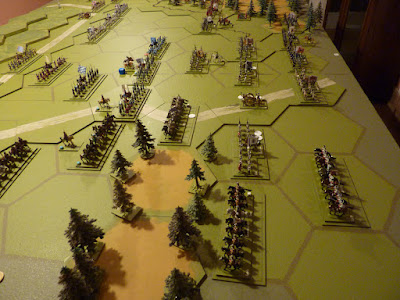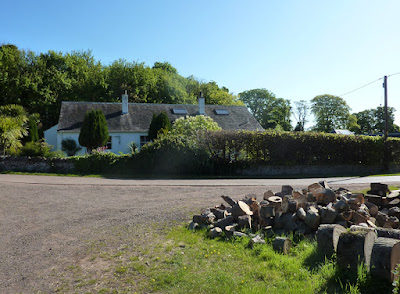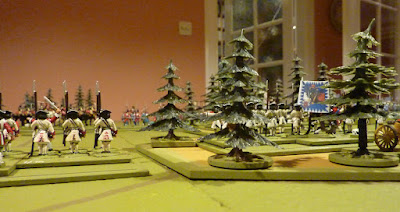Another Zoom night on Thursday to test the infant CJ Lite. JBM was there, complete with a (French) McDonald's takeway, and we were lucky enough to have the estimable Jon Freitag fly in from the US. I was host and umpire, so I got to concentrate on remembering my own rules. A few things did slip under the radar, but by and large it went very well.
Wargaming in the West Wing
The scenario was the same one we used last week - on this occasion JBM took the part of FM Schlick, commanding the Imperial forces, and Jon was the Elector of Bavaria, which is only right and proper, considering the distance he had travelled.
This game was rather more strenuous than the previous test - certainly the umpire found it so!
Spoiler to start. Jon's Bavarians got off to a brisk start, then suddenly the Austrians pulled a remarkable switch, and shifted the cavalry from their right wing into the centre, leaving the flank wide open and their enemy not a little shocked. The Bavarians attacked in businesslike style, building up a good lead in Victory Points, then JBM threw in everything, including the cavalry he had shifted into the centre, and clawed it back level. The score went from 6-2 for the Bavarians to 7-4, then 7-6, then 8-all...
Then Jon, having already lost his hot-shot mounted Leibgarde on his right wing, eliminated one of Schlick's Hessian cavalry units, and won the day at 9-8. What a fight! Schlick himself was badly wounded, while encouraging his infantry in the woods, and was removed from the field, so he was not around at the end to suffer the routine abuse.
View from the Bavarian left, early on. Some general manoeuvring on the flanks. The villages of Sankt Roman (left) and Schießdorf (right) visible at the far end of the table. Yes, it's that scenario again
At the other end, Weichel's Bavarian cavalry are opposed by Stoltz's boys. Just probing at this stage
Though the Austrian Lobkowicz cuirassiers took a bit of a whacking from the elite Leibgarde
Early elimination of the Lobkowicz regiment evened things up a bit on this flank, since Weichel's brigade was smaller than Stoltz's to begin with
4-1 to the Bavarians at this stage; Schlick attacks in the centre, Furneburg's infantry brigade going in through the woods. On the right of the picture you can make out Niederhammer's cavalry brigade, on the Austrian right flank, beginning their surprise move into the centre
In next to no time, Arco's brigade on the Bavarian left found that they were opposed by a large space. Arco himself had been an early casualty, so there may have been a little hesitancy over what to do about it
From the Bavarian side of the field you can see the big Austrian push building up in the centre
Around the villages, the troops are slugging away
Wheeling round behind the Austrian army, Arco's brigade came upon one of the battalions from Furneburg's brigade, with Furneburg himself attached. This little action didn't take up a lot of time - the infantry unit was eliminated, though Furneburg himself survived. He took an option which may be familiar to C&C veterans: he retreated off the table, thus denying the enemy the chance of gaining another VP by capturing him and, since the rules do not allow him to return, he was able to get an early table for dinner at the Wilder Mann in Passau
Around this time the Austrians managed to get 4 consecutive activations, which is unheard of, and took full advantage. As the Elector stated after the battle, "they came roaring back". The just-visible red cube marker in the woods is evidence that Schlick was still present at this point - eventually he was wounded at this location
Throwing in everything within reach of the centre, including the relocated cavalry of Niederhammer, the Austrians got the VP score back to 8-8. At this stage, it is customary to say "it could have gone either way", but on this occasion that's a little too obvious, even for me
When the Bavarians finally drew an activation cube of their own, after being starved out for a while, they eliminated one of Stoltz's cavalry units in a relatively quiet part of the field, and they had won. Deservedly, but it was certainly tense at the end
...the woods are full of Austrians - 20mm wonderland - 50 year-old soldiers and 60 year-old trees...
...but the wise old scoreboard knew the truth; he deals only in facts, and he has seen it all before, boys and girls
Very pleased with the game and the testing; the rules stood up well to a bit of stress. The very few issues were down to the author of the rules forgetting (for example) to allow cavalry to evade when attacked in close combat, otherwise all very positive. It is all a learning process. My sincere thanks to my guests for a very jovial evening, and for their enthusiasm and companionship. Jon did very well with the unfamiliar rules (though they are similar to several things he has played regularly), and I know he is a very busy man at the moment, so I appreciate his visit. JBM upstaged us all with the food delivery - never even offered me a chip.
My recent switch to the smaller cans of Red Bull meant that I had to have two of them. No-one complained that this might indicate some Austrian bias. As a result I was still in great form when reading my gardening books at 3am, so it definitely gave me wings.
Thanks again, guys. My next steps will be to polish up the rule book a little, and then try to set up a multi-player Zoom game. Hmmm...
Bavarian
Army (Elector of Bavaria) (7
horse; 12 foot; 2 art; 5 leaders)
Arco’s
Brigade (Generalmajor Johann Baptist, Graf d’Arco)
Arco Kürassiere (3 Sqns)
Costa Kürassiere (3 Sqns)
Monasterol Dragoner (3 Sqns)
Santini Dragoner (3 Sqns)
Weichel’s
Brigade (Generalmajor Rademel Von Weichel)
Leibgarde (3 Sqns)(elite)
Weichel Kürassiere (3 Sqns)
Wolframsdorf Kürassiere (3 Sqns)
Brinkelhof’s
Brigade (Generalmajor Gottlieb Brinkelhof)
IR Bettendorf (2 Bns)
IR Haxthausen(2 Bns)
Boismorel Grenadiere (1 Bn)
Leib Grenadiere (1 Bn)(elite)
1 field battery
Maffei’s
Brigade (Generalmajor Alessandro, Marquis de Maffei)
IR Lützelberg (1 Bn)
IR Kurprintz (1 Bn)
IR Maffei (1 Bn)
IR D’Octfort (1 Bn)
IR Spilberg (1 Bn)
IR Tattenbach (1 Bn)
1 field battery
Imperial
Army (Feldmarschal Leopold von Schlick) (8 horse; 11 foot; 2 art; 5 leaders)
Niederhammer’s
Brigade (Generalmajor Heimo Niederhammer)
Alt-Hannover Kürassiere (3 Sqns)
Cusani Kürassiere (3 Sqns)
Gronsfeld Kürassiere (3 Sqns)
Aufseß Dragoner (3 Sqns)
Stoltz’s
Brigade (Generalmajor Johannes Stolz)
Jung-Darmstadt Kürassiere (3 Sqns)
Lobkowitz Kürassiere (3 Sqns)
Leibregiment zu Pferd (Hessen-Kassel)(3 Sqns)
Spiegel Karabiniere (Hessen-Kassel)(3 Sqns)
Furneburg’s
Brigade (Generalmajor
Michael, Furst von Furneburg)
[3 units have battalion guns]
IR Alt-Salm (1 Bn)
IR Gschwind (2 Bns)
IR Palffy (1 Bn)
IR Thürheim (2 Bns)
1 field battery
Backer’s
Brigade (Generalmajor Jean-Pierre Von Backer)
IR Lothringen (3 Bns)
IR Scharfenstein (2 Bns)
1 field battery



















































